You probably see the dollar bill every day, but have you ever thought about the symbols on the dollar bill and what they mean?
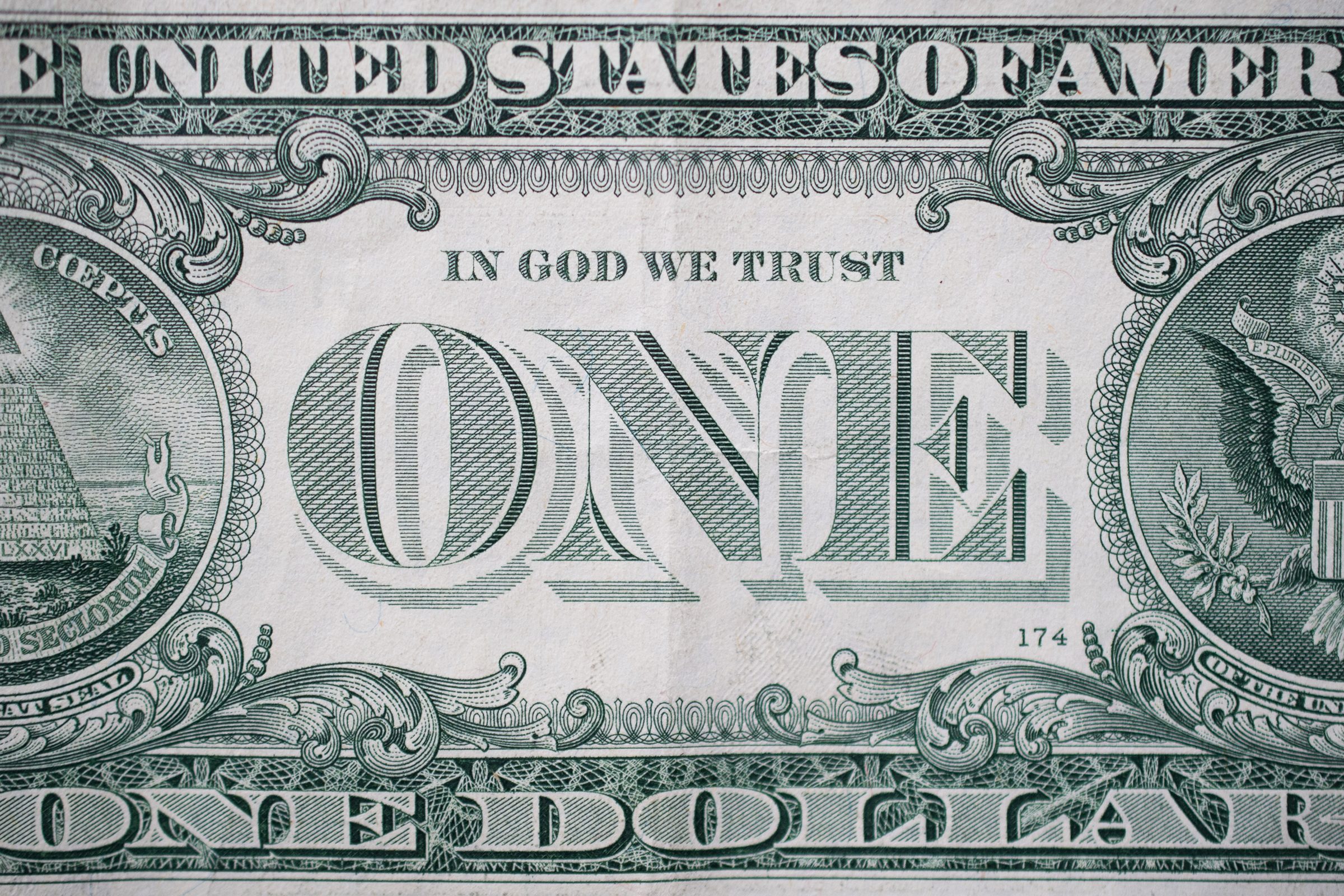
Here’s What the Symbols on the U.S. One Dollar Bill Mean

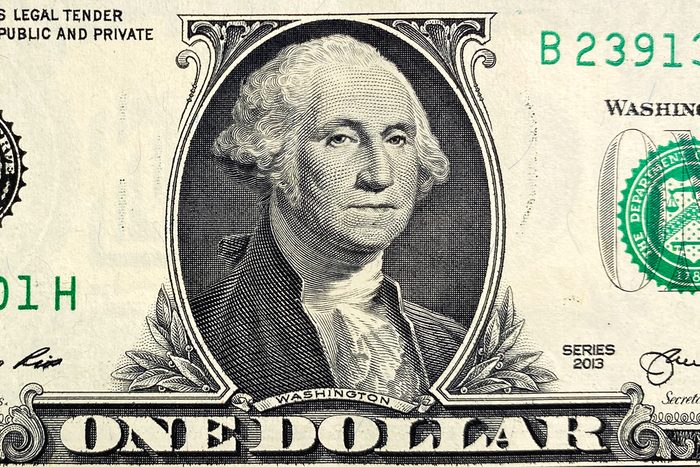
George Washington’s portrait
The United States’ first president, George Washington, has been on the front side of the one-dollar bill since 1869, Maurer says. His portrait is framed in an oval on the center of the bill, with the surname “Washington” written at the bottom. The engraving is based on the American painter Gilbert Stuart’s 1796 oil painting of Washington known as the “Athenaeum Portrait,” deftly named after being acquired by the Boston Athenaeum soon after the artist’s death.

Leaves
Leaves appear in multiple places on the front side of the dollar bill, including around the border as well as at the bottom of Washington’s portrait. These are laurel leaves, according to Maurer, which are “associated with honor and wisdom—and also military victory, which is relevant for General Washington.”
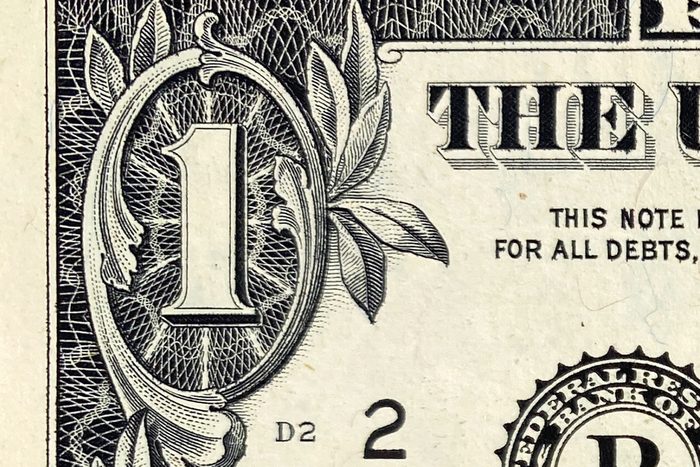
Design around the ones
There is a number one on each of the corners of the front side of the one-dollar bill, indicating its value. Surrounding each of these number ones you’ll find an intricate pattern. “The use of fine lines in the patterns in the spaces around the numbers indicating the note’s denomination is called guilloché,” Maurer says. As it turns out, many countries’ banknotes use this kind of design feature as a form of counterfeit deterrence, he explains. “But what’s fun about it is that it derives from metalwork, not printing,” he says. “Our notes are produced from engraved sheets of metal; the people at the Bureau of Engraving and Printing are skilled engravers who pass on techniques from generation to generation to make the plates from which the notes are printed.”
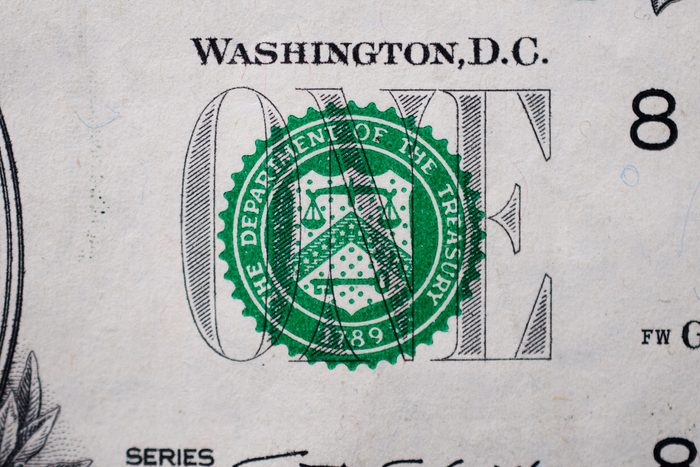
Department of the Treasury seal
The green seal of the Department of the Treasury is stamped on the right side of the front of the one-dollar bill over the word “ONE” written out in capital letters. The year 1789, which was when the Department was created, is printed at the bottom of the seal. Within the seal appears a coat-of-arms-style shield featuring balancing scales and a key. “The scale represents fair and honest measurement,” Maurer says. “The key represents security—think of locking things up in a safe or vault.” Also appearing in the shield is a chevron design with 13 stars to represent the original 13 states.
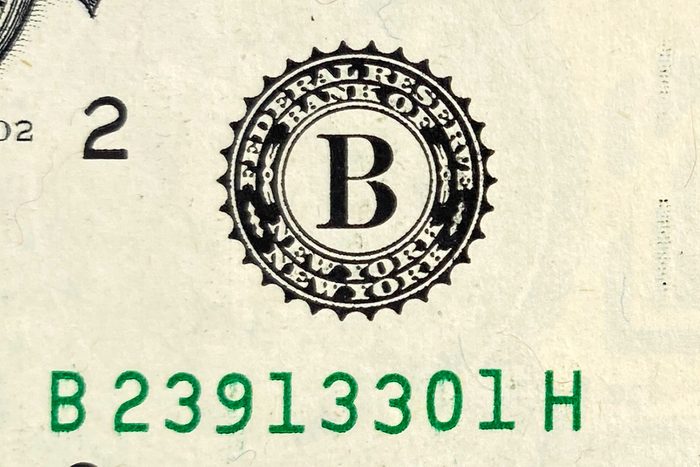
Letter in a circle
To the left of Washington’s portrait on the front side of the dollar bill appears a letter (from A through L) inside a circle, surrounded by the seal of the Federal Reserve. “The Federal Reserve seal tells you which Fed branch issued [the note] into circulation,” Maurer says. Each letter corresponds to a different branch and is also the first letter of the serial number printed on the note, he explains. The numbers printed in the four corner areas of the “open” space on the front also indicate the Federal Reserve branch.
Curious about the Federal Reserve branch code symbols on the U.S. one-dollar bill? Here’s a breakdown:
- Boston: A / 1
- New York: B / 2
- Philadelphia: C / 3
- Cleveland: D / 4
- Richmond: E / 5
- Atlanta: F / 6
- Chicago: G / 7
- Louis: H / 8
- Minneapolis: I / 9
- Kansas City: J / 10
- Dallas: K / 11
- San Francisco: L / 12

Note position letter and number
In addition to the Federal Reserve branch codes, there are two other letter-number combinations on the front of the one dollar bill with hidden meaning. According to Maurer, these are the sheet codes which are “part of the printing process for organizing the notes, ensuring sequential serial numbers, and providing a way to check for printing errors and then gather up any notes from that one same sheet that contain those errors.”
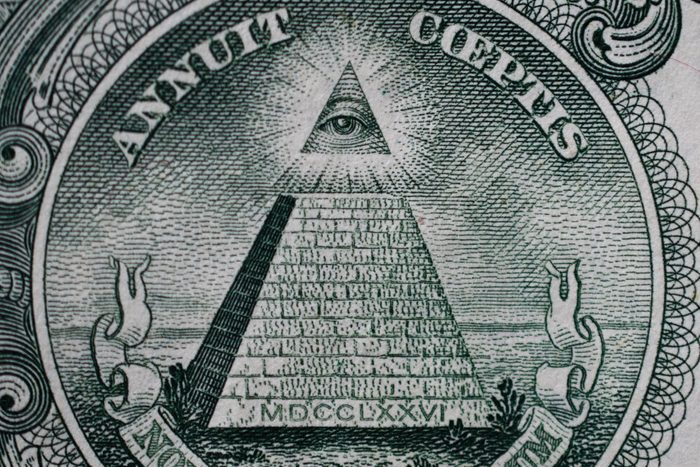
Pyramid
Out of all symbols on the U.S. one-dollar bill, the pyramid is one of the most mysterious. It’s found on the left side of the back of the one- dollar bill. “This feature is one side of the Great Seal of the United States, and it was designed back in 1782 by some of our founding fathers,” Maurer says. “The pyramid is supposed to represent stability and timelessness.” If you look closely, you’ll notice that the pyramid has 13 steps, representing the 13 original colonies. (More on the number 13 in a bit!)
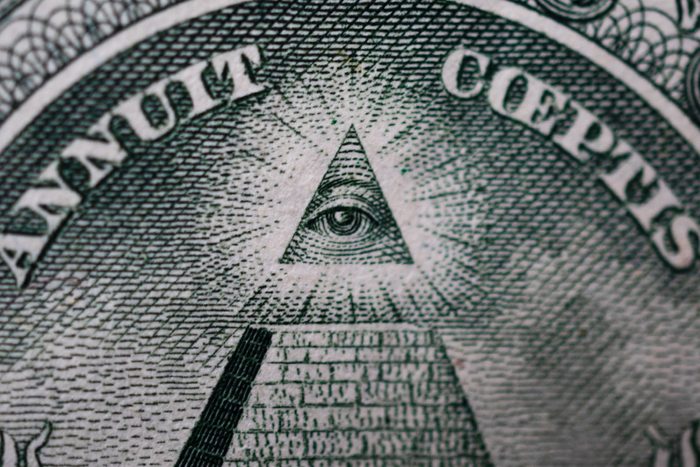
Eye above the pyramid
A triangle, surrounded by rays of light, floats about the unfinished pyramid structure; within the floating triangle is an eye. This is “the Eye of Providence watching over and ensuring the endurance of the structure of the American government— [also known as] the ‘American experiment,'” Maurer says. The Eye of Providence is also associated with Freemasonry, the oldest fraternal organization in the world, and was regularly featured on Masonic buildings and churches in the 1700s. While it can be fun to follow the rabbit hole of dollar bill conspiracies, the BBC notes that the Eye of Providence “tells us much more about late 18th-Century aesthetics than it does about the authority of secret elites.”

Letters on the base of the pyramid
A string of letters appears at the bottom of the pyramid on the back of the 1 dollar bill: “MDCCLXXVI.” According to Maurer, this is the Roman numeral for 1776, representing the year the United States declared independence from Great Britain.

Eagle
On the right side of the back of the American dollar bill there is an eagle inside a circle. While there is no explanation of why an eagle was chosen in the official records, we do know that one of the original design proposals for the Great Seal featured a small crested white eagle, which is not specific to America. However, the bird was later changed to the bald eagle, which is uniquely American. Another interpretation, though unsupported, suggests that the eagle also represents victory and independence.
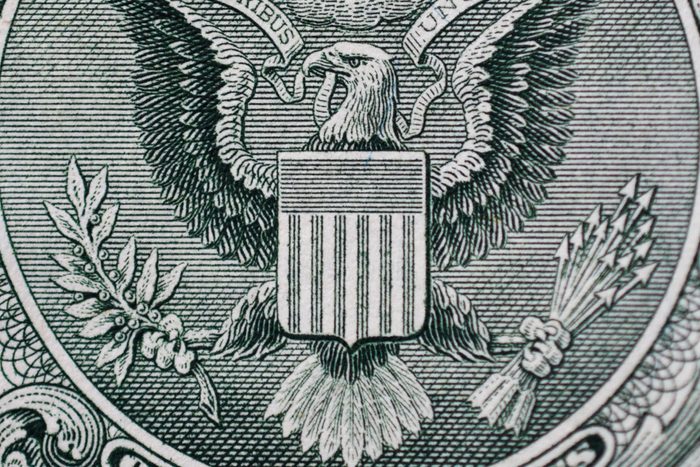
Eagle’s shield
In front of the eagle appears an unsupported shield. Charles Thomson, the Secretary of the Continental Congress from 1774 through 1789 and a key player in refining the Great Seal’s imagery, noted that the unsupported shield represents the power of the United States relying on its own strength and virtue rather than that of foreign aid. The horizontal lines at the top of the shield represent Congress, while the vertical green and white stripes represent the red and white stripes of the American flag.
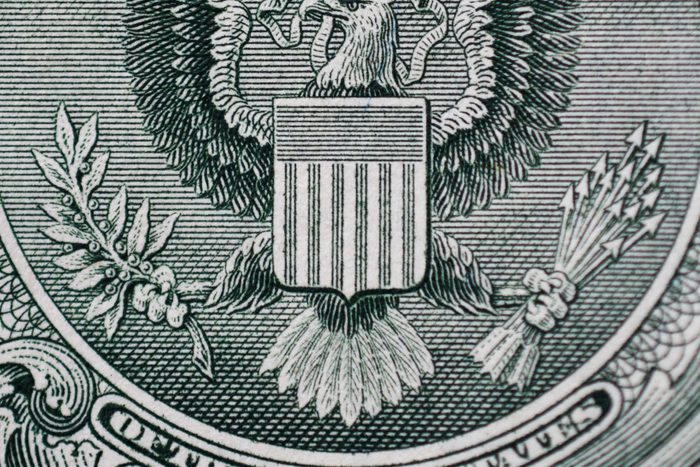
Eagle’s talons
The eagle holds 13 arrows in its left talon and an olive branch with 13 leaves in its right. The arrows and olive branch represent war and peace, respectively; notably, the eagle is facing the olive branch.
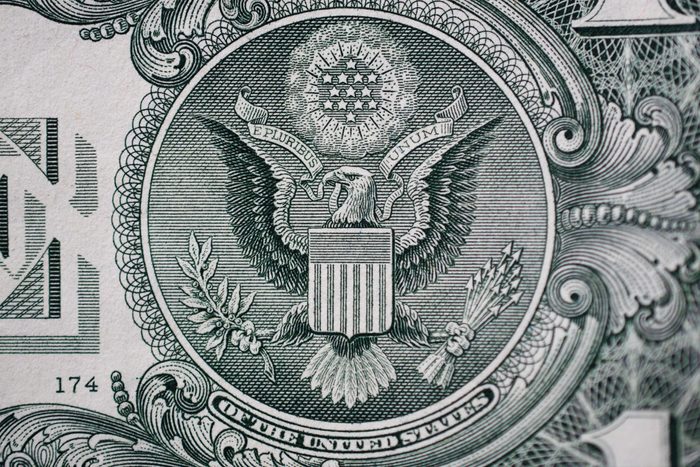
Collections of 13
As you’ve probably noticed, “you will find 13 of everything everywhere” on the one-dollar bill, “all representing the original 13 colonies,” Maurer says. In addition to all of the examples that we’ve already mentioned, there is are also 13 stars floating above the eagle’s head on the back of the one-dollar bill.
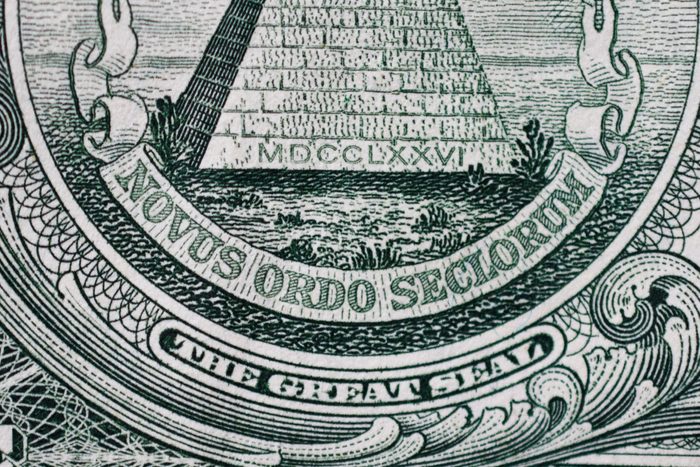
Latin phrases
Three Latin phrases appear on the back of the 1 dollar bill: the phrase, “Annuit Cœptis,” which appears over the pyramid; “Novus ordo seclorum,” written on a banner below the pyramid and “E pluribus unum,” etched on a banner in the mouth of the eagle. According to Maurer, the first phrase means “Providence favors our actions,” while the second reads as “new order for the ages.” The third phrase translates to “out of many, one.”
These phrases all speak to the idea of American exceptionalism. “These phrases in their historical context refer to the mythology of the United States as an exceptional nation, favored by God, which ushered in the age of states not defined by blood or religion but by the ideas of the Enlightenment,” Maurer explains. “That is the ‘novus ordo’ that the phrase is referring to—the new order that supplants fealty to kings and instead adheres to the ideas of liberty and equality.”
FAQs
What does it mean if there’s a star on your dollar bill?
If you see a star at the end of a serial number on a one-dollar bill, Maurer suggests keeping it, noting that it’s worth something to collectors. “Stars are used whenever the Bureau of Engraving and Printing detects a printing error and has to redo a sheet of notes,” he explains. “The Bureau destroys the sheet with the printing error but picks up the serial numbers where that sheet would have ended, adding the star to indicate this.” Other collectors’ items include notes with interesting serial numbers like 00000000.
Are there any plans to redesign the one-dollar bill?
In short: Not at all. “The design of the $1 bill is set by the Financial Services and General Government Appropriations Act, which prohibits the redesign of the note,” Maurer says. Plus, the one-dollar bill is rarely counterfeited, which is why there’s no real need for a redesign. It also has minimal security features. “These are limited to red and blue fibers you can see on close inspection, as well as the intaglio printing caused by the high-pressure printing presses that are used for all banknotes,” he says. “These give our banknotes their distinctive feel— there are grooves and ridges because of the pressure of those printing presses.”
Do any of these symbols appear on other currency?
Remember that guilloché design around the ones? Many other countries also use this design feature on their currency as a form of counterfeit deterrence, according to Maurer. Pyramids have also appeared on other currencies, including a former 10-pound Egyptian (EGP) banknote that was circulated from 1970 through 1978; a 100-pound Sudanese (SDG) banknote from 2021, featuring the Pyramids of Meroë and a 20-peso Mexican (MXN) banknote used from 1973 through 1992, which showcased the Teotihuacan pyramids.
About the expert
|
Why trust us
At Reader’s Digest, we’re committed to producing high-quality content by writers with expertise and experience in their field in consultation with relevant, qualified experts. We rely on reputable primary sources, including government and professional organizations and academic institutions as well as our writers’ personal experiences where appropriate. We verify all facts and data, back them with credible sourcing and revisit them over time to ensure they remain accurate and up to date. Read more about our team, our contributors and our editorial policies.
Sources:
- Bill Maurer, PhD, anthropology professor at the University of California, Irvine and editor of A Cultural History of Money (2019).
- Board of Governors of the Federal Reserve System: “Currency in Circulation: Volume”
- Bureau of Engraving and Printing: “$1 Note”
- National Museum of American History:“1 Dollar, Legal Tender Note, United States, 1862”
- United States Senate: “George Washington”
- S. Department of the Treasury: “Seal of the Treasury Department”
- BBC: “The Eye of Providence: The symbol with a secret meaning?”
- The Grand Lodge of Ohio: “Behind the Masonic Symbols: The Eye of Providence”
- S. Department of Veterans Affairs: “Celebrating America’s Freedoms”
- National Archives: “Original Design of the Great Seal of the United States (1782)”




















